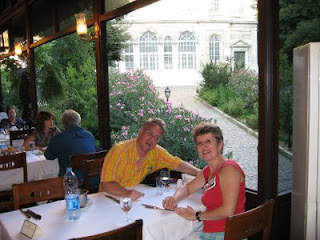After I finished final edits on my Dummies book this summer, we needed a getaway from Bucharest. So we jumped on a plane and flew to Istanbul, Turkey. I have two Turks among my Latin students, fine young men.
Look, I know that every country has its losers, but I have to say that from what I saw, the fine young men I teach are representative, not exceptions. In Istanbul, ten men got up at once when they saw my wife board the tram. Each one competed for the honor to give up their seat.
I'm praising Istanbul and its people even though I will share that I was pick-pocketed. Folks, I'm a world traveler and take full responsibility for what happened. We were rushing to catch a tram after walking a long distance. I bought our tokens and, taking my change, stuffed a note equivalent to 20 USD in my pocket. I ordinarily secure my money in a wallet which is then safety-pinned in my pocket. I didn't do that this time. When we got off a crowded tram in which I had been surrounded on all sides by people, that note was gone. I choose to believe that whoever took it needed it worse than me and I hold no ill will against him.
Here we are at a restaurant which overlooks the courtyard of a Greek Church.
 I tasted Yeni Raki for the first time at that restaurant. I'm sipping some right now as I write this post. It's basically Turkish Uzo.
I tasted Yeni Raki for the first time at that restaurant. I'm sipping some right now as I write this post. It's basically Turkish Uzo.I will eventually have other things to share about our lovely vacation in Turkey, but today I want to share an idea I have about an unsolved mystery there. In our third day in lovely and exotic Istanbul, we were checking off the final "must see" points of the city. On our way to jump the tram to head toward a boat ride across the Bosphorus (so my wife could say she's been in Asia), we visited the famed Basilica Cisterns (Yerebatan Saray).Built by Justinian in 542, they at one time held 60 million gallons of fresh water for the use of the Imperial city. At the far end of the cistern is a curious attraction discovered only after the cistern had been emptied and prepared to become a tourist attraction. All of the stone used to build the cistern had been cannibalized from other buildings. I had noticed, for instance, that a number of columns in the cistern bore a distinct teardrop shape that I had also seen on a pillar laying in front of our hotel in Beyazit.
From some unknown location, the people who constructed the cistern had reused two Medusa head statues as the base for two columns. The heads are positioned, one sideways, the other upside down. The heads are in the far end of the cistern, their faces pointing away from the main area of the attraction. Here they are:

 The literature says that researchers assume that the positioning of the heads was intentional, but to this point no one has suggested a credible reason for the heads being in this precise configuration. Attempts to explain it have tended to focus on aspects of the Medusa myths, with one claiming that there was a practice of putting Medusas upside down.
The literature says that researchers assume that the positioning of the heads was intentional, but to this point no one has suggested a credible reason for the heads being in this precise configuration. Attempts to explain it have tended to focus on aspects of the Medusa myths, with one claiming that there was a practice of putting Medusas upside down.I have thought about this issue for months. I am going to suggest a new possibility. My theory will have virtually no true evidence to support it. As such this idea isn't really something one could write up as a professional article. I'm suggesting that an explanation of the positioning of the Medusas should be seen in the actual cultural and historical context of the building of the cistern itself. Justinian was embarking on a number of building projects, including the cistern. But he also had just recently promulgated a new code of law. The Justinian Code included capital punishment, by beheading, for several offenses not previously punishable by death. Among these were homosexual acts and apostasy.
Let's imagine that an architect or builder working down in that cistern was unhappy with the new law. He has two Medusa heads available to him for use as base stone. What better way to silently lodge a protest than to depict a beheading? By positioning the two heads sideways and then upside down, the builder depicts a head rolling after being beheaded. This is further highlighted by the use of Medusa, who was herself beheaded by Perseus.
Since we may assume that Justinian himself may have wanted to inspect the project upon its completion, the builder faces the heads away from the center and puts them in the far corner, since it was unlikely that the Emperor would really go that deep into the project so as to see the far wall and the columns next to it.
But as the cistern was filled with water, the builder would always know that he had left a little inside joke inside the Emperor's prized cistern. If the builder were a closet pagan or sympathizer, he could know that a beheaded Medusa was poisoning those waters, if even symbolically.

Fascinating! I'm dying to know more.
ReplyDeletean inside joke to the emperor, eh? that's one cool theory!
ReplyDeletep.s. thanks for dropping by my blog earlier :-)